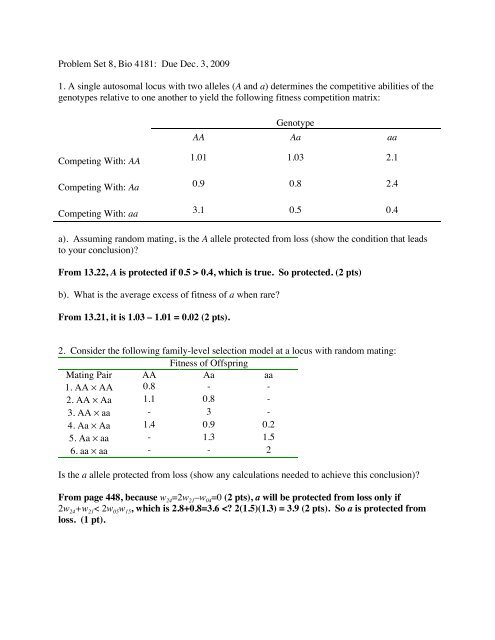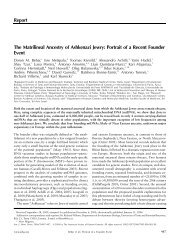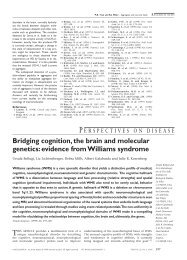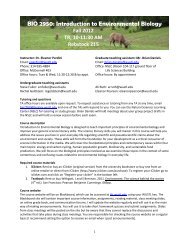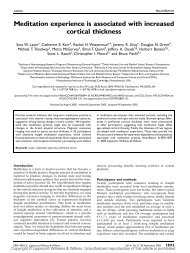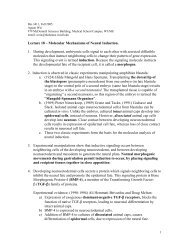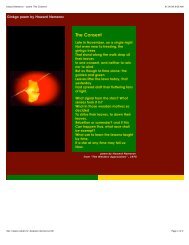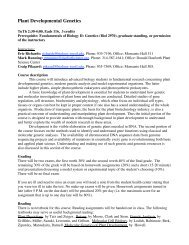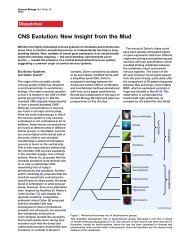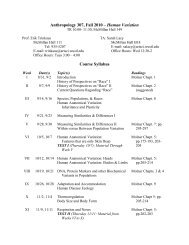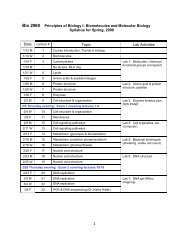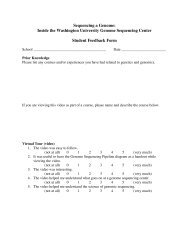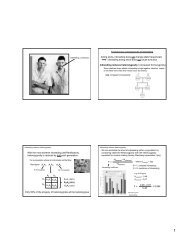problem set 8 2009 key
problem set 8 2009 key
problem set 8 2009 key
You also want an ePaper? Increase the reach of your titles
YUMPU automatically turns print PDFs into web optimized ePapers that Google loves.
Problem Set 8, Bio 4181: Due Dec. 3, <strong>2009</strong><br />
1. A single autosomal locus with two alleles (A and a) determines the competitive abilities of the<br />
genotypes relative to one another to yield the following fitness competition matrix:<br />
Genotype<br />
AA Aa aa<br />
Competing With: AA 1.01 1.03 2.1<br />
Competing With: Aa 0.9 0.8 2.4<br />
Competing With: aa 3.1 0.5 0.4<br />
a). Assuming random mating, is the A allele protected from loss (show the condition that leads<br />
to your conclusion)?<br />
From 13.22, A is protected if 0.5 > 0.4, which is true. So protected. (2 pts)<br />
b). What is the average excess of fitness of a when rare?<br />
From 13.21, it is 1.03 – 1.01 = 0.02 (2 pts).<br />
2. Consider the following family-level selection model at a locus with random mating:<br />
Fitness of Offspring<br />
Mating Pair AA Aa aa<br />
1. AA × AA 0.8 - -<br />
2. AA × Aa 1.1 0.8 -<br />
3. AA × aa - 3 -<br />
4. Aa × Aa 1.4 0.9 0.2<br />
5. Aa × aa - 1.3 1.5<br />
6. aa × aa - - 2<br />
Is the a allele protected from loss (show any calculations needed to achieve this conclusion)?<br />
From page 448, because w 24=2w 21–w 04=0 (2 pts), a will be protected from loss only if<br />
2w 24+w 21< 2w 05w 15, which is 2.8+0.8=3.6
3. Consider a Levene model of a random-mating population that is completely randomly<br />
dispersed every generation across three environments such that the relative fitnesses for the<br />
genotypes determined by an autosomal locus with 2 alleles are:<br />
Env.<br />
Genotype<br />
AA Aa Aa<br />
1 1 1 0.8<br />
2 0.8 1 1.1<br />
3 1.05 1 1<br />
Which of the following niche outputs under a soft selection model will protect the polymorphism<br />
loss (show the conditions that leads to your conclusion):<br />
a). c 1=0.2, c 2=0.2, c 3=0.6<br />
b). c 1=0.1, c 2=0.5, c 3=0.4<br />
c). c 1=0.1, c 2=0.8, c 3=0.1<br />
Use the conditions:<br />
i<br />
1<br />
∑<br />
ci vi
6. A large population consists of only AA individuals at an autosomal locus with random mating<br />
such that the population is stable in size and the number of progeny is given by a Poisson<br />
distribution. A new mutation occurs, a, such that Aa individuals have an average of 1.05<br />
offspring and a variance of 2 in the number of offspring.<br />
a) What is the probability of a surviving in this large population?<br />
Use equation 14.20 (2 pts). First calculate s=0.05 (1 pt). Second, note that the variance in<br />
2<br />
offspring number = 2 =1+s+σ s (1 pt), so the probability of survival = 0.1/2 = 0.05 (1 pt)<br />
b) Assume now that Aa individuals also have a Poisson number of progeny, but still with a<br />
mean of 1.05. What is the probability of a surviving in this population now?<br />
First calculate s=0.05 (1 pt). Second, note that the variance in offspring number =1+s =<br />
1.05 (2 pts), so the probability of survival = 0.1/1.05 = 0.095 (1 pt).<br />
7. A recessive allele, a, is associated with two different life history phenotypes in a population<br />
with overlapping generations such that:<br />
AA & Aa aa<br />
x l x m xb x l x m xb x<br />
0 0.8 0 0.5 0<br />
1 0.7 0.5 0.4 4<br />
2 0.6 1 0.3 3<br />
3 0.2 1 0.2 1<br />
4 0.1 0.2 0.1 0<br />
Calculate the fitness of both phenotypes using a) the net reproductive rate, and b) the Malthusian<br />
parameter (use an approximation).<br />
Use equations 15.1 (1 pt) and 15.10 (1 pt).<br />
AA & Aa aa<br />
x l x m xb x l xm xb x xl xm xb x l x m xb x l xm xb x xl xm xb x<br />
0 0.8 0 0 0 0.5 0 0 0<br />
1 0.7 0.5 0.35 0.35 0.4 4 1.6 1.6<br />
2 0.6 1 0.6 1.2 0.3 3 0.9 1.8<br />
3 0.2 1 0.2 0.6 0.2 1 0.2 0.6<br />
4 0.1 0.2 0.02 0.08 0.1 0 0 0<br />
R 0= 1.17 2.23 R 0= 2.7 4<br />
r= 0.076233184 r= 0.425<br />
1 pt for R 0, 1 pt for r 1 pt for R 0, 1 pt for r


